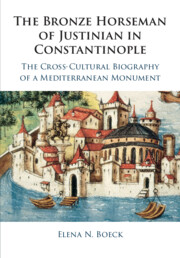 The Bronze Horseman of Justinian in Constantinople
The Bronze Horseman of Justinian in Constantinople Published online by Cambridge University Press: 08 April 2021
In 839/40 the horseman caused the emperor Theophilos (829–42) and the residents of Constantinople tremendous concern by dropping its gilded toupha, the plumed helmet-crown. The horseman’s behavior was interpreted as an ominous, foreboding action. Theophilos had repeatedly aligned himself with the horseman in his triumphs of 831 and 837 by wearing a toupha, and a toupha also makes an unprecedented appearance on Theophilos’ copper coins. The golden toupha encapsulated the splendors of triumphal rulership and interlinked Theophilos with Justinian. The bronze horseman had become the symbol of victory and a testament to the return of Byzantine martial prowess. The horseman dropped the toupha in the aftermath of Theophilos’ humiliating defeat by the Abbasids in 838. An urgent and ingenious restoration is narrated in the chronicle of Symeon the Logothete. While previous scholarship has recognized Theophilos’ architectural competition with the Abbasids, the horseman has not been included in analyses of cross-cultural dialogue. This chapter argues that Justinian’s horseman came to symbolize the city and serve as a harbinger of the imperial future. The bronze horseman's "actions" were interpreted in Constantinople as divinatory indications of the future of the Byzantine–Abbasid rivalry.
To save this book to your Kindle, first ensure [email protected] is added to your Approved Personal Document E-mail List under your Personal Document Settings on the Manage Your Content and Devices page of your Amazon account. Then enter the ‘name’ part of your Kindle email address below. Find out more about saving to your Kindle.
Note you can select to save to either the @free.kindle.com or @kindle.com variations. ‘@free.kindle.com’ emails are free but can only be saved to your device when it is connected to wi-fi. ‘@kindle.com’ emails can be delivered even when you are not connected to wi-fi, but note that service fees apply.
Find out more about the Kindle Personal Document Service.
To save content items to your account, please confirm that you agree to abide by our usage policies. If this is the first time you use this feature, you will be asked to authorise Cambridge Core to connect with your account. Find out more about saving content to Dropbox.
To save content items to your account, please confirm that you agree to abide by our usage policies. If this is the first time you use this feature, you will be asked to authorise Cambridge Core to connect with your account. Find out more about saving content to Google Drive.